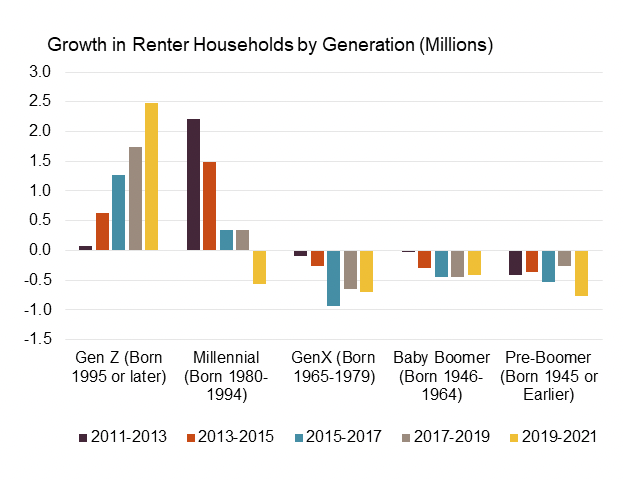Daniel McCue, Senior Research Associate at the Joint Center for Housing Studies, released a report showing that after decades of driving growth, the number of renter households headed by millennials—those aged 28-42 in 2022—has peaked and is declining.
While slowing multifamily construction has emphasized a significant downturn in rental markets, optimists are seeing rental demand hold strong and point to favorable demographics as a reason to remain optimistic.
But are demographics truly favorable for rental housing?

This large cohort has reached ages when more households are transitioning into homeownership rather than forming new renter households. Gen Z—aged 13–27 in 2022—is now the only generation adding renter households. Therefore, demand for rental housing will continue to grow only if the number of new Gen Z renter households outnumbers losses among older generations who are leaving rental units due to homeownership transitions or mortality.
According to McCue, in many ways, this is the end of an era.
"In the 2000s and 2010s, millennials in their late 20s and 30s ushered in a surge in the number of renter households, not only because the cohort is larger than previous generations but because millennials rented at higher rates than earlier generations at the same age," he said.
But can we expect Gen Z to continue either of these trends to uphold the levels of growth in renter households seen over the past 15 years?
A major factor determining whether Gen Z forms as many renter households as millennials did before them is how many people are in this generation relative to millennials. According to U.S. population estimates for 2022, there are 66.1 million people in the 15-year cohort aged 13–27 who make up Gen Z, compared to 67.8 million people aged 28–42 who make up the millennial generation.

Based on this data, Gen Z is currently not as large a generation as millennials, but close enough to maintain similar levels of rental households.
However, if we dig deeper, we find that Gen Z today is 2.1 million larger than millennials were at similar ages 15 years ago. Adding up the overall population of our 15-year generational cohorts, we find a total of 66.1 million Gen Z people aged 13–27 in 2022, compared to 64.0 million millennials aged 13–27 in 2007.
It is supported by historical U.S. birth records, which show the highest levels in Gen Z birth years (1995–2009) and a historical peak in births in the late 2000s for Gen Z people who are in their early 20s today.
As the number of millennials in the U.S. grew by nearly 4 million over the past 15 years as a result of gains from immigration, the surge was so large because it was the years millennials passed through their 20s and 30s, ages where immigration rates peak.
This could be occurring now for Gen Z, the oldest of whom are in their 20s. But can we expect the population of Gen Z to increase as much from immigration over the next 15 years as the millennial population did over the last 15 years?

On one hand, it is entirely possible because the last 15 years include years when immigration rates hit historic lows. On the other hand, immigration rates are highly unpredictable, and the future of immigration policy is particularly challenging right now and subject to contentious debate.
The number of renter households Gen Z adds in the next 15 years will be an important pillar of rental housing demand, and the extent to which the size of the Gen Z population grows in the next 15 years ultimately could determine whether the number of renter households in the U.S. grows, stabilizes, or declines in the coming years.
This growth, which is so highly dependent on immigration levels over the coming years, directly connects the future of rental housing demand to immigration policy and represents just one of the many links between housing and immigration.
But population growth among Gen Z is just one factor that will determine future rental demand, along with the rates of household formation and homeownership among this generation and the speed at which millennials and older generations transition to homeownership or otherwise exit rental markets.
To read the full report, including more data, charts, and methodology, click here.

 theMReport.com Your trusted source for mortgage banking news
theMReport.com Your trusted source for mortgage banking news








